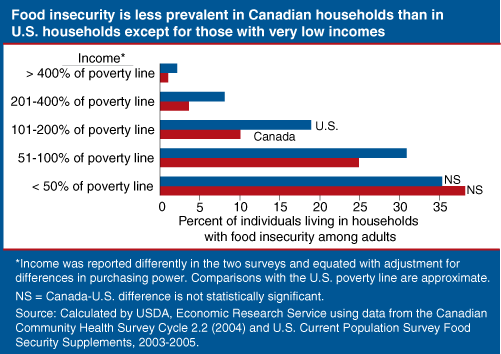Food Insecurity Less Prevalent in Canada Than in the United States
- by Mark Nord
- 6/1/2009
Canadian households are less likely to face difficulty putting adequate food on the table than those in the United States, and this disparity does not appear to result from differences in income. Food security—defined as access by all people at all times to enough food for an active, healthy life—is important for health and good nutrition. Nationally representative Canadian and U.S. surveys, using the same set of questions to assess food security, indicate that 7.0 percent of Canadians lived in food-insecure households in 2004, compared with an average of 12.6 percent of U.S. residents in 2003-05.
To a great extent, the same demographic and economic characteristics were associated with food insecurity in both countries. Younger adults, single parents, unemployed adults looking for work, adults out of the labor force because of disability, and people in households where no adult had completed a 2- or 4-year college degree were more likely to live in food-insecure households. Food insecurity was also strongly associated with low income in both countries.
Canada has, on balance, smaller proportions of these vulnerable subpopulations than the United States. In particular, Canada has a higher proportion of college graduates and a lower proportion of children living with a single parent. However, differences in demographics, employment, and income could account for only 20-30 percent of the overall Canada-U.S. difference in food insecurity.
Differences in income and income distribution did not contribute to the lower rate of food insecurity in Canada. A smaller percentage of Canadians than Americans lived in food-insecure households in every income range except the lowest—below about 50 percent of the U.S. poverty line. (Income was adjusted for differences in purchasing power in the two countries.)
The Canada-U.S. difference in food insecurity primarily reflected lower rates of food insecurity in Canadian households than in U.S. households with similar incomes, employment, household living arrangements, age of members, and education. Holding other factors constant, food insecurity was less prevalent in Canada than in the United States for households with incomes just above the U.S. poverty line, those with no high school graduate, those with children present, and those with adults age 25 and older. Partially offsetting these factors were lower rates of food insecurity in the U.S. for households with incomes below the U.S poverty line and for men living alone and women living alone.
These patterns suggest that differences in tax and tax-credit policies and the provision of in-kind benefits (such as food and nutrition assistance, health care, housing assistance, and energy assistance) may account for a substantial share of the difference in food security between Canada and the United States. Evidence from the ERS study is not definitive, however, and further research is needed to explore the reasons behind the differences.
This article is drawn from:
- Nord, M. & Hopwood, H. (2008). A Comparison of Household Food Security in Canada and the United States. U.S. Department of Agriculture, Economic Research Service. ERR-67.
You may also like:
- Food Security in the U.S.. (n.d.). U.S. Department of Agriculture, Economic Research Service.


